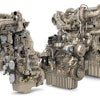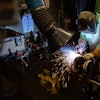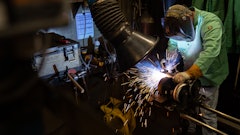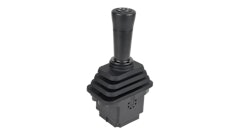The world's automakers have pretty much perfected the art of power steering for their vehicles. Smooth, precise and virtually effortless steering is the norm on everything from the smallest of the new breed of "city cars" to big SUVs.
It is a very different story in the world of articulated construction equipment such as wheel loaders, and yet another story in the world of material handling forklifts. Achieving anything remotely close to the automotive experience on these vehicles requires a lot of careful engineering and attention to detail because everything — from steering geometry to system components to vehicle dynamics — has to be accounted and compensated for.
Articulated "jerks"
In steering jargon, "jerk" is not meant as a derogatory word. It's an engineering term for what happens at the beginning and end of a steering maneuver on an articulated vehicle. These vehicles typically have a pivot point near the center, and often the operator is positioned forward of it. Steering is accomplished with a pair of hydraulic cylinders that literally "bend" the vehicle one way or the other to change its direction of travel.
Jerk occurs when the operator initiates or stops steering. It is measured as the derivative of acceleration in G/sec. The problem with jerk is that it is felt by the operator in the cab with 8 G/sec being a typical maximum value for mid-size and large equipment. Being subjected to an 8 G/sec jerk hundreds of times per shift can be a major factor in operator fatigue and creates obvious wear and tear on the equipment.
The traditional way to reduce jerk has been to install and include cushion valves or accumulators in the hydraulic circuit. This method is effective, but also adds cost and complexity to the steering system. These extra components simply divert some of the hydraulic fluid to the accumulator or take some fluid from the accumulator to smooth out the pressure spikes that are the actual cause of jerk. This approach treats the symptoms of the problem but does nothing to eliminate the root cause.
A better solution is to meter the rate at which fluid is added to, or removed from, the cylinders in real time to reduce the amplitude of the inevitable pressure spikes. This capability can be designed into the steering control valve by increasing the deflection angle between the spool and the sleeve to reduce the gain rate of the steering flow/pressure curve.
Gain rate is a measurement of the change in flow rate versus valve deflection. By increasing the deflection angle, by as much as a factor of four in the steering valve, it will take longer for the flow rate to reach its peak. Increasing the gain rate over a longer time period will now result in a lower absolute magnitude of the resulting jerk.
An example of this solution is the Wide Angle™ and cylinder damping "wide angle technology" incorporated in steering control valves manufactured by Eaton. By simply substituting a valve with Wide Angle technology for a conventional valve in a load sensing system, the jerk is cut by a factor of two or more with no other modification to the system. No additional accumulators or cushion valves are needed.
Eaton's Hydraulics Operations originally introduced Wide Angle technology on its Series 20 valves which are large, high-flow units intended for very large equipment such as articulated dump trucks and loaders used in construction and mining applications. The company recently has made this patented technology available on its Series 10 steering control units, which can be used on smaller vehicles.
This is a good example of the industry trend toward migrating proven technologies from large, high-end equipment to smaller, mass-market vehicles. Availability of Wide Angle technology on Series 10 steering control units makes it cost-effective to apply smooth steering to vehicles like log skidders and loaders. Since there are many more vehicles of this class in use, the total productivity impact of reduced operator fatigue will be much larger.
There are some applications where Wide Angle technology by itself is not sufficient to tame steering jerk. In those cases, a cylinder damping feature can be added to control the rate at which fluid is added to or evacuated from the steering cylinders. This is a pure flow control technique that uses metering orifices in the steering control unit or valve to permit excess pressure to bleed off back to the reservoir during pressure spikes.
Both Wide Angle technology and cylinder damping provide a substantial reduction in the magnitude of the jerk the operator experiences every time the vehicle changes direction. From the operator's perspective, that translates directly into less fatigue and greater productivity. From the equipment owner's perspective it can mean reduced maintenance requirements and potentially a longer service life for the vehicle.
Fast or slow
In addition to jerk, designers of articulated vehicle steering systems have to deal with the contradictory requirements of steering at high speeds and low speeds. With current market trends producing agricultural and construction vehicles with top road speeds of 50 kph and more, this will become an increasingly important issue.
At high vehicle speed, as when moving between areas on a large jobsite or on the road, the steering needs to be precise and variable. That may mean up to six complete turns of the wheel from lock to lock. At low vehicle speed, as when picking up or depositing a load in a wheel loader, the steering needs to be "quick" to avoid operator fatigue. That means no more than two or three rotations of the wheel from lock to lock.
Some OEMs and suppliers address this contradictory requirement by installing dual systems. For example, such a system might use a conventional steering wheel for high-speed operations when more precision is needed and a joystick for low speed steering to move around the worksite quickly. The operator has to decide which system to use and select it with a switch or other device.
Obviously, this is a less than ideal solution. It introduces additional components, cost, and complexity to the steering system, and it requires the operator to remember which steering device is engaged at any point in time. There are also safety issues that must be addressed with such systems. For example, it's quite possible for an operator to bump the steering wheel when operating with the joystick, and the system needs built-in safeguards to prevent an unsafe result. These, of course, add both cost and complexity.
A better solution uses a single steering device, usually a steering wheel, to control both modes and change the response rate to meet vehicle requirements. Eaton's VersaSteer™ and two-speed systems are good examples. They both have operator-selectable steering modes built into a single, compact steering control unit.
One mode is for normal high-speed roading and also provides a fail-safe emergency steering capability in case of power loss. The second, or quick steering, mode lets the operator perform fast turns repeatedly with minimum effort during the work portion of the duty cycle.
Eaton also offers a variable ratio and flow amplified steering system called Q-Amp™ that varies the steering flow and displacement based on the speed at which the wheel is turned. This provides improved high-speed steering control and improved productivity at low speeds during the work cycle with no operator decision required. The Q-Amp system also can allow a smaller gerotor section to help save space and provide emergency steering in certain applications. The Q-Amp system is also applicable to lift trucks.
Lift trucks
Lift trucks are subject to their own set of challenges. One issue is that the operator normally cannot see which way the steering wheels are pointed. Obviously, this is also true of an automobile, but in an automobile the relationship between the steering wheel (inside the vehicle) and the steering wheels (on the pavement) is fixed.
This is not always the case on a hydraulically-steered lift truck because internal bypass flows in the system can, and do, change the relationship between steering wheel position and the position of the steered wheels. One solution to this situation is a system that automatically synchronizes steering wheel position with the steering angle on the steered wheels.
An example of this is the Eaton Electronic Sensor Proportional Valve Active Control System (EPACS) that uses a position sensor on the steering column and a position sensor on the kingpin of one of the steered wheels to report their relative positions to an onboard computer. The computer calculates the difference and then applies flow to the appropriate side of the system to synchronize the two. Systems of this type are virtually standard equipment on lift trucks used in Japan, where the EPACS system was developed.
One advantage is that an operator always knows which way the vehicle will move, so it is not necessary to make a tentative movement of the vehicle before applying a correction. Another advantage is that the commonly used steering knob attached to the steering wheel can be placed in a more ergonomic position. At the end of the day, those advantages translate into reduced operator fatigue and a measurable productivity improvement.
What's next?
Hydraulic steering systems are changing and improving rapidly to meet the evolving needs of industrial and agricultural users. One area under intense development is the "steer-by-wire" concept that integrates electronic controls and communication into the steering system, thereby replacing traditional hydrostatic steering with a proportional valve.
Contemporary examples include agricultural equipment that is guided by GPS signals, and mining, construction, and other equipment intended for hazardous areas. Steer-by-wire systems will interface with other onboard sensors to provide capabilities including stability control, speed sensitive steering, and advanced monitoring and control of vehicle dynamics in the near future.
While this technology will see its first application on industrial and construction vehicles, it will eventually find its way into the automotive market as legislative mandates for improved safety and efficiency change the way automobiles are built and used. In the end, smooth steering technology will not only make industrial vehicles drive more like automobiles, it will make automobiles safer and more efficient, as well.
Mark Reitz is product manager for steering control units, Eaton Corp., Eden Prairie, MN.















